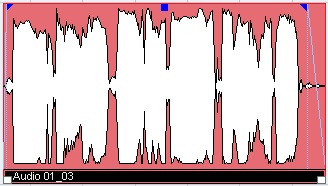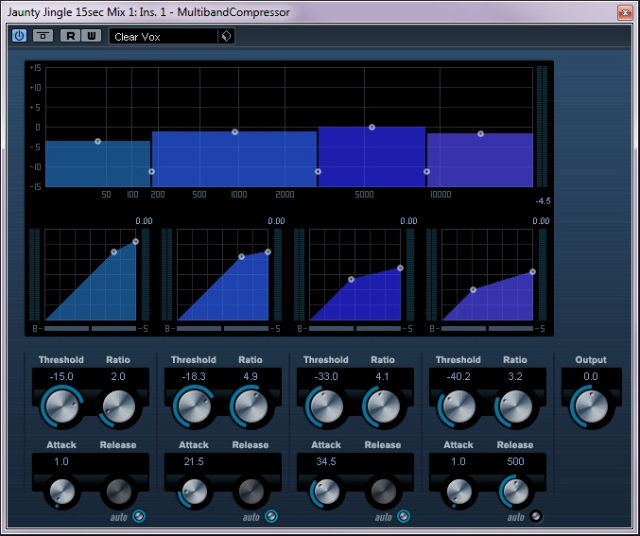Are you using compression correctly on the voice overs and audio files in your video productions? Are you using any at all? Compression in real terms means competition…
If you’re not using compression on the audio in your videos, your work could fail to measure up to your competitors. It’s true that things have got louder over the years; television programmes, adverts and music have become more and more compressed. Whilst I personally dislike very heavy compression, (most Katy Perry songs give me a headache..) the right amount will help give your voiceovers depth and definition, and make your overall audio sound polished and improved.
So how do you go about achieving the right results?
Ideally you should aim to improve the sound of your production but not over compress it. A compressor in basic terms ‘squashes’ the sound but can also have the effect of making audio sound louder, ‘jump out’, smoother and with less dynamic range.
Usually you will have access to some sort of compressor plug-in within your video production suite. I would advise setting up a compressor on your voiceover / speech tracks if you have them, and if you can, over all your audio tracks together (you may need to use a bus or group track to achieve this.) Whether you apply your overall compressor before or after roughly mixing the audio tracks is personal preference. I like to have a mild compressor on the whole mix from the start so that when I’m mixing the audio I can hear it and it’s not so much of a change.
A word of warning – applying your overall bus / group compressor should be done with care as it will change the sound of the whole video. If your compressor has presets try anything called ‘light compression’ or ‘gentle mix compression’.
Compressing a voice correctly will help any voiceover, vox pop or piece to camera be clearly audible and have a warm, pleasing tone. One of the main reasons for using compression is that there will be less peaks and troughs in your audio – making it tighter and stronger. Speech will be less easily lost and stand out against any foley or music (which most likely will have been compressed rather a lot). Again, look for a suitable preset or see the settings under ‘Single Band Compressor’ below.

Compressed Vocal

Highly Compressed Vocal
Glossary

Light Compressor
Single Band Compressor
A simple compressor usually with controls such as Ratio and Threshold. A good article on what these controls do along with Gain controls and how they work can be found on the ever useful Sound on Sound article base. Get to know what each parameter does and notice the difference in sound. if you’re getting stuck, try a preset as mentioned before. You can always tweak the settings of a preset – they can be good starting points.
Also there’s a good definition of Ratio from Audio Issues.com :

Heavy Compressor
“The ratio is where you determine how much compression you are going to apply to a signal that goes over your threshold. For every signal that goes over the threshold, it gets compressed according to a certain ratio. For example: A compressor with a threshold at -10dB and a 3:1 ratio is a nice starting point for vocals. If you have a semi-constant level of the vocal at -1dB it will become compressed so that it only reaches -7dB”
Multi Band Compressor
A compressor with more than one frequency band. This can be useful when mixing music as you can control and compress the bass frequencies (which are the loudest frequencies) seperate to the higher frequencies.

Multiband Compressor
Limiter
A harsher compressor with a higher ratio, usually used on a final mix.
Normalize
A Normalize function will bring the volume of audio up to a specified level, eg. 0db or -3db. However, be careful as it will also bring up any low level hiss and raises the noise floor. It is better to aim for a louder signal (without clipping) when recording. Normalize does not squash the signal or reduce dynamic range as a compressor does – it’s basically just like turning the volume up.
Loudness Maximiser
A Loudness Maximiser is a special kind of limiter, capable of achieving the brain-poundingly loud masters used by pop and rock music. Note that there is a difference between a volume level, say in decibels, and perceived loudness. A track which has been compressed or processed may sound louder but may not actually be louder in volume. As this has become a real problem in regards to TV stations having louder and louder adverts, there is actually a new metering specification in Europe to try and counteract the issue. More information on this can be found in this Wikipedia article.
If you have any questions I will do my best to answer them. Please note that this is only a rough outline on compression, but should be enough to get you started and get the audio on your videos sounding smoother, cleaner, louder and polished.



Pingback: Tweets that mention 10 Minute Tips: Using Audio Compression in Videos | clairecomposer -- Topsy.com
Pingback: What Makes You So Special? 10 Minute Tips: Audio in Video | clairecomposer